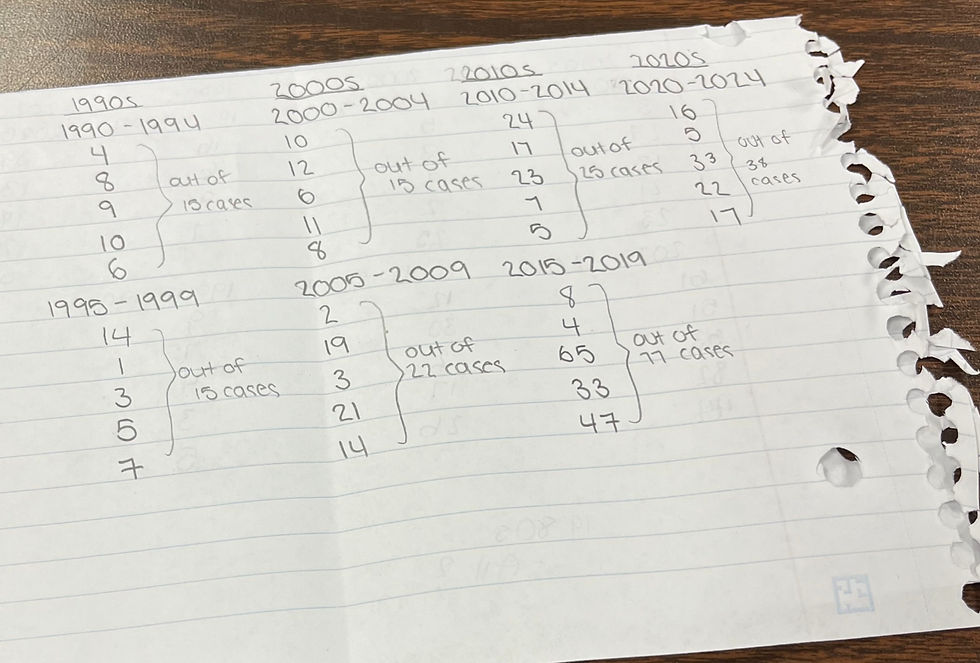Blog 2- Academic Conversation and Inquiry Process
- Sienna Collins
- Dec 1, 2023
- 4 min read
Updated: May 3, 2024
Context:
The context behind my research project is mostly about copyright and mostly in the music industry. "Copyright is when an artist can authorize someone else to copy their music or other art forms" (US Copyright Office). To find more context behind copyright cases in the music industry I found a couple of studies that informed my research. One of those studies was called "Determining Whether What Sounds Alike is Alike" which talks about different components of songs that can be copyrighted and show up most often in cases. These include, melody, lyrics and other components. This is what I based my research on along with an article about what artists should know about copyright cases and how to avoid them. I used some of these parameters on what not to do, to pick what components I am researching for my project.
Gap:
The gap that I found in my project through research was copyright infringement cases in the music industry and the patterns surrounding them. Most of the sources I have found through research is about copyright cases in general, not specifically looking at ones involving music. Also, they mostly stick to one side of copyright while not going as in-depth as I've went in my research.
Methodology:
When coming up with my methodology, I first needed to find a way to pick the different cases to use for my research. To do this, I started researching different studies on court cases and how they selected the court cases. From this I learned that they used a random sample. After finding the method of selection, I needed to decide how many cases I wanted to analyze. From researching I found that a sample should be at least 10% of the population. With this research in mind, I chose 5 decades to study, starting from the 1980s since that is when copyright infringement cases became more popular and the amount increased. After finding those 5 decades, I needed to choose the cases from those decades. In order to receive a variety of years of cases, I decided to split each of those decades in half and randomly selected 5 cases per each half of a decade. I found all of these cases on a website called GW Law and Blogs that contained every copyright case in order from the 1800s to 2020s. This website was very helpful in my collection process since it had all of the cases in one place.

Picture taken from my phone
Once I selected all of the cases, I was able to start data collection. In order for my data to be organized, I created a spreadsheet with all of the cases and every component that I planned on analyzing. This was so I could have all my data in one place. Also it would make analyzing the data easier after finishing the collection.
Along the way I have had to change my methodology in order to account for the limited time and for some of the roadblocks I have had to deal with. In the beginning, I was going to research every copyright infringement case that was on the website after the 1980s but due to time constraints I had to cut down to only about 50 cases. Another way that I had to shift my methodology is to change it to only cases that originated in the United States. This was because, I was unable to find information on some of the artists involved in those cases.
Progress in data collection:
I have collected the majority of my data. There are some pieces that are still missing, but this is because I can't find some of the information. Since the data collection is mostly done, I have now started data analysis. To do data analysis I am creating many different graphs from the data that I have collected. I collected data from about 10 different components including, the ethnicity of each artist along with gender, age, and genre. I am then comparing that to the outcome of each case.

Screenshot of my spreadsheet
I have done this for each of the 5 decades that were chosen.
Roadblocks:
I have encountered many roadblocks throughout my research process. To begin, I came across an issue regarding individual artists of different copyright cases and finding background information on them. For the cases that occurred outside of the United States, it was harder to obtain information on the artists. So instead of looking at cases both inside and outside of the United States, I decided to stick to ones only in the United States. I also came across that less popular artists and smaller artists are harder to find information on such as the age and ethnicity of the artist. This is going to be a limitation in my research, but I am trying to combat this by including as much information I can as possible.
Results:
So far, from the data analysis I have conducted and what I've seen from my data collection is that the defendant has been winning the majority of the cases since the plaintiff does not have a very strong case. I've also noticed a correlation between the popularity of an artist and the outcome of the case. More popular artists are winning against smaller artists. I have not found out enough to figure out if this is connected to popularity or if the cases were not strong enough. Once I have finished all of my data analysis, i will be able to come to a more exact conclusion.

As you can see the two main ethnicities are American (White) and American (Black)
For more information in a different format:





Comments